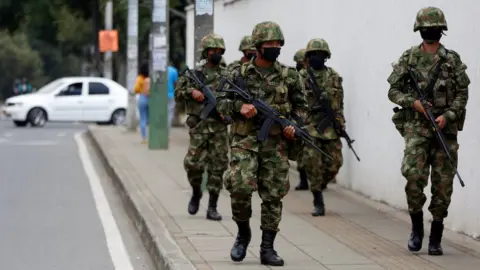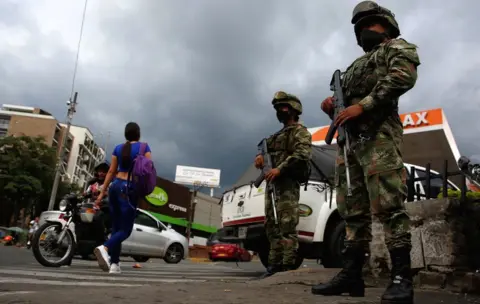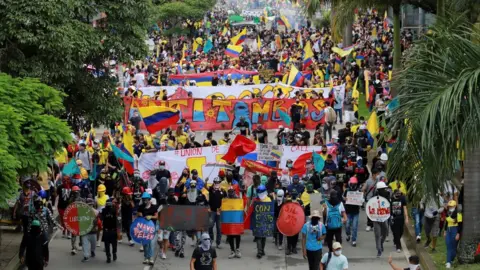Colombia protests: Duque sends military to Cali
 EPA
EPAThe Colombian army has begun to tighten its control over the city of Cali following weeks of deadly anti-government protests there.
Streets are reported to be largely deserted after President Iván Duque ordered the military intervention.
At least five people died in Cali on Friday night, the latest casualties in a month of protests which have claimed dozens of lives.
The protests began in April over a proposed tax increase.
The tax plan was withdrawn but the protests grew to cover police violence, poverty and Colombia's health crisis.
Two weeks of negotiations between the government and protesters have stalled.
Cali, which has become the epicentre of the protest movement, is under curfew until Saturday morning.
 EPA
EPAThe military intervention includes several other areas of the country.
Demonstrators in the capital, Bogotá, said they would return to the streets on Sunday to call for a halt to police violence.
Speaking at a news conference in Cali, Mr Duque said he was sending in the "maximum deployment of military assistance" to the police.
"This deployment will almost triple our capacity in less than 24 hours throughout the state, ensuring assistance as well at critical points, where we have seen acts of vandalism, violence and low-intensity urban terrorism," he said.
One of those killed on Friday was an off-duty official in the attorney-general's office. The man opened fire on protesters before he was killed, Attorney General Francisco Barbosa said in a statement.
On Saturday, a security official in Cali said at least five people had died on Friday in the unrest. He said a further five people had been killed in the city, but it was unclear if these deaths were directly related to the protests.

Explosive cocktail
Analysis by Daniel Pardo Vegalara, BBC Mundo
Cali sits at a strategic point in the south-west of Colombia - connecting the urban centre to the Pacific Ocean and the biggest port in the country, Buenaventura.
During the pandemic, the number of people in poverty in Cali increased three times more than in the rest of the country.
Much of its economy is informal and it has a diverse population. It also has a high number of murders. That cocktail, in a very unequal and segregated city, was fuel for the protests.
But then came the strong response of the authorities, who have treated many protesters as criminals because of the roadblocks they have set up and which are seriously affecting the region's economic activity.
The rage of both sides is huge. And with dialogue attempts having failed, it doesn't seem as though it'll calm down at any point soon.

How did the protests begin?
The demonstrations started on 28 April and were initially in opposition to a proposed tax reform which would have lowered the threshold at which salaries are taxed.
The government argued that the reform was key to mitigating economic difficulties but many middle-class Colombians feared they could slip into poverty as a result.
 Reuters
ReutersAfter four days of protests across the country, President Duque said he would withdraw the draft legislation.
However, human rights groups accused police of using tear gas and, in some cases, live ammunition to disperse the protests.
Dozens of people have since died.
On Friday, Colombians marked one month since the protests began with marches across the country.
